I am Narrows, Seymour Narrows
Published on June 10th, 2023
The 7th edition of the 750 mile Race to Alaska (R2AK) began June 5 with a 40-mile “proving stage” from Port Townsend, WA to Victoria, BC. For those that finished within 36 hours, they were allowed to start the remaining 710 miles on June 8 to Ketchikan, AK. Here’s the Stage 2/Day 3 report:
Compared to the rip roarin’ genesis of Stage 2’s start, most of what followed R2AK’s second dawn was exciting in the subtle nuances of the minimalist exuberances of a Japanese tea ceremony: intricate, practiced, methodical, and slow.
If the teams of R2AK hopefuls spent the moments after the Victoria start hitching their wagons to Juan de Fuca’s westerly wind sleigh ride, most of Day 2 was spent in deliberate and opportunistic slowness; rowers and paddlers made miles one scoop of water at a time, sailors pedaled to the next maybe of wind and sailed one tiny puff at a time.
Things were slow and intricate, but slower than you think; until Seymour Narrows’ river went in the right direction, R2AK Day 2 was Tai Chi in a vat of oatmeal.
The seven teams in the lead pack made excruciating miles on pedals and the lightest of breezes that were mostly downwind, but often only theoretically. The wind was liiiight, so light that it wasn’t often clear where it was coming from. The kind of flat calm where you can count the trees by their reflection. Wind so light that bugs fly past you. Jerks.
The lead pack was making miles on the sweat of their brow, pedaling, pedaling, drag racing flies while trying to keep their spirits up. Across the mid to northern parts of the Strait of Georgia, at least 30 humans worth of muscle rotated through pushing more than 20,000 pounds of boats that were never designed for it.
While measuring this would take more PhDs and James Bond tech than R2AK could ever hope to acquire, but after hours of pedaling on jury-rigged bike seats we can imagine the portion of human brain dedicated to wanting to sail increases with the portion of the human butt that is dedicated to wanting a couch.
We caught up with the ever-pedaling souls aboard Team Budgie Smugglers and asked them which parts of them were the most sore. Their answer: “We can’t tell if it’s the blisters or the hemorrhoids, but we’re almost out of cream.” There are many ways teams prepare for this race, but of all the preparations, Preparation H is the one that tends to slip through the cracks.
Seven lead teams, some hemorrhoidal, all within sight of each other. Why were they eeking every ounce of performance out of whatever mix of human and wind driven speed they could find? A closing window to transit Seymour Narrows before its natural river flowed south and threw 8 knots of unhelpful current and a sea of driftwood at anyone trying to head north.
If you haven’t experienced Seymour Narrows, imagine a river at flood stage running through a two mile wide canyon. Now imagine that a 2 year old is at the controls, and keeps dialing it up, dialing it down, and then switching its direction. All that water moving at once is impressive, but the changing nature of it means the predictable eddies and whirlpools of a river simply don’t exist, at least for long.
Whirlpools open up out of nowhere, drop down three feet, swirl over to the other shore, collide with another one or a boat wake, transform, and then disappear. Sea level is a baseline from which we measure all heights, but in Seymour Narrows there are drops of three feet or more into the center of whirlpools, and literal hills when that water comes boiling back to the surface.
Then the river switches directions and does the whole thing in the opposite direction, four times a day, forever. Even for people who have seen it before (and we’ll admit to a bit of whirlpool tourism by the R2AK media team) it is still awe- and giggle-inspiring if you’re in a boat with fossil-fueled horsepower, and absolutely impassable at the wrong time if you’re on the pedals.
By early afternoon any hope to scoot through before the tide changed turned into a game to seek the best positioning for the next window—a tidal challenge onto itself. From Cape Mudge north, the approach to Seymour is the outflow of the river and tidal currents upwards of 5 knots are common in the middle of the channel.
Like rivers, the effect of the shoreline often creates eddies, counter-currents that spin off of rocks and cause the river to flow the opposite direction near the shore. Lead teams clawed themselves forward as close to the beach as they could get without scraping, until they simply couldn’t.
Team Ruf Duck made it first and farthest, getting to the waiting room bay just east of the narrows. Team We Brake for Whales got to a few miles south of there before currents built and legs tired. They threw out the anchor, broke out the food and a bottle of bourbon to wait.
In the only adventure race we know of that sometimes includes a pub, Team Mojo made the classy, and dare we say, French choice and ducked out of the current through the marina entrance in Campbell River. They tied up, then walked up the dock to wait out the tide over what we can only assume was a multi-course, plated meal in the Riptide Pub. A few drinks and a classy dinner, they wiped the corners of their mouths with cloth napkins and went back to racing.
The effect of all this tidal business is that the seven teams in the front had to wait for six hours, which allowed the middle pack to catch up for the same tidal gate. Teams Unsalted Nuts, Ship of Fools, and Dacron and Denim had been tens of miles behind. But this morning finds them in Johnstone Strait within swearing distance of Team Ruf Duck that was the leader by miles before they had to sit in the tide gate penalty box.
More than a sumo-sized strategic factor to wrestle with for race tactics, once you get green light at Seymour Narrows you have to go through the tidal rapids without an engine. On top of that, yesterday all of those teams went through Seymour at night. Scary, and to the chagrin of the media team and tracker fans worldwide, a night transit of Seymour Narrows produces the kind photos that only a mother with night vision goggles could love.
That’s what was happening at the front, here’s some news from the back pack of small and human powered vessels:
• Despite yesterday’s Maytag-inspired amusement park in the straits of Juan de Fuca, Team Toybox Express looked fresh and fly in Trincomali Channel and still in their matching Buffalo-plaid onesies. Only a few miles into Day One, a couple of big waves came into their Hobie Tandem Island. They discovered that the waterproof hatches were indeed hatches, but not the other part. The small, bailable wells they sat in were quickly small bathtubs beyond bailing.
“My knees were dry but the rest of the boat was fully submerged,” said Dawson Lucier. “Everything was floating.” The kayak had completely filled with water, every single compartment was overflowing.
They were okay. They were in dry suits, sort of dry, and the boat’s amas kept them afloat.
The pedal drives kept working, so they bee-lined to the rocky shore of D’Arcy Island, where they spent the better part of four hours wringing out sleeping bags and laying things out in the sun. After a damp night’s sleep, they were underway and undeterred.
“We’re not going to wave the white flag. We got a little ground to make up today but we’re still here, we’re still rolling with it and spirits are high.”
• More on Team Zen Again Dog’s injury from the man himself:
“Okay…..here is the post that starts, I am all right…. I had a mishap with Minnie last night, where she rolled over me, on rocks, and caused enough damage for me to go to hospital this morning, which is done. There are no breaks, just a hematoma in my right arm, and the puncture in my left arm is okaywithout stitches. The necessity of going to hospital should indicate that this was bad enough for me to pull out. At the same time I am lucky, lucky there are no breaks, lucky it wasn’t my head that got scrunched under the boat, and lucky that there was a tracker [follower] nearby who has taken me in and I’m being looked after. Pete and Diane…thank you!”
• Report on Team Of One from a passing boat:
“Of One is rowing around like it’s a weekend at the lake. There’s almost nothing that’s not in a hatch, he’s wearing light clothes, no hat, and spoke with us almost as if he was about to get up and grab another drink. He exhibits a positive, subdued nonchalance that is bafflingly understated.”
This checks out with every interaction that anyone has ever had with Dameon, solo rower of Team Of One, and 2019 R2AK veteran as half of the double rowing Team Backwards AF. Talking to Dameon is like to an extension of earth, we’ve never met a more grounded person
***
As of posting 10 teams are through Seymour, with another six that might make today’s matinee of favorable current. A wall of wind awaits the teams as they exit Johnstone Strait and the pedals of the last two days look to be replaced by deep reefed sails and mainlining dramamine. Hang tough out there racers, Bella Bella awaits!
Race details – Entry list – Tracker – Facebook
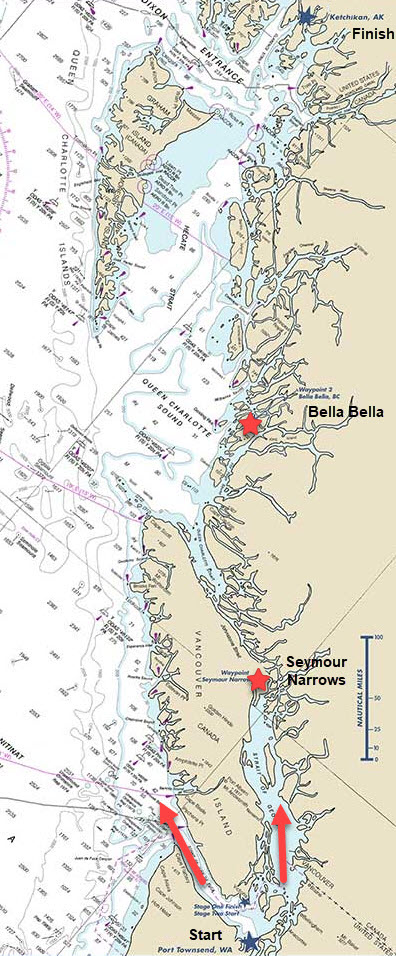 The 7th edition of the Race to Alaska in 2023 will follow the same general rules which launched this madness in 2015. No motor, no support, through wild frontier, navigating by sail or peddle/paddle (but at some point both) the 750 cold water miles from Port Townsend, Washington to Ketchikan, Alaska.
The 7th edition of the Race to Alaska in 2023 will follow the same general rules which launched this madness in 2015. No motor, no support, through wild frontier, navigating by sail or peddle/paddle (but at some point both) the 750 cold water miles from Port Townsend, Washington to Ketchikan, Alaska.
To save people from themselves, and possibly fulfill event insurance coverage requirements, the distance is divided into two stages. Anyone that completes the 40-mile crossing from Port Townsend to Victoria, BC can pass Go and proceed. Those that fail Stage 1 go to R2AK Jail. Their race is done. Here is the 2023 plan:
Stage 1 Race start: June 5 – Port Townsend, Washington
Stage 2 Race start: June 8 – Victoria, BC
While the Stage 1 course is simple enough, the route to Ketchikan is less so. Other than a waypoint at Bella Bella, there is no official course. Whereas previous races mandated an inside passage of Vancouver Island via Seymour Narrows, the gloves came off in 2022. For teams that can prove their seaworthiness, they now had the option of the western route.
There is $10,000 if you finish first, a set of steak knives if you’re second. Cathartic elation if you can simply complete the course. R2AK is a self-supported race with no supply drops and no safety net. Any boat without an engine can enter.
There were no races in 2020 and 2021 due to the pandemic. In 2022, there were 45 starters for Stage 1 and 34 finishers. Of those finishers, 32 took on Stage 2 of which 19 made it to Ketchikan.
Source: R2AK






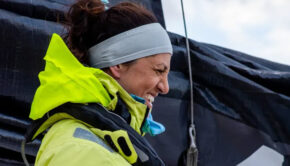
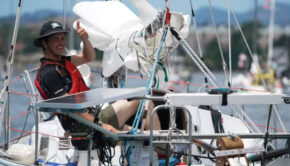
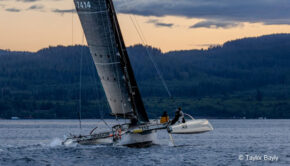
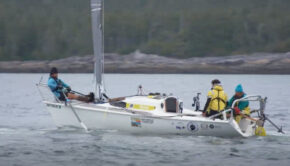
 We’ll keep your information safe.
We’ll keep your information safe.